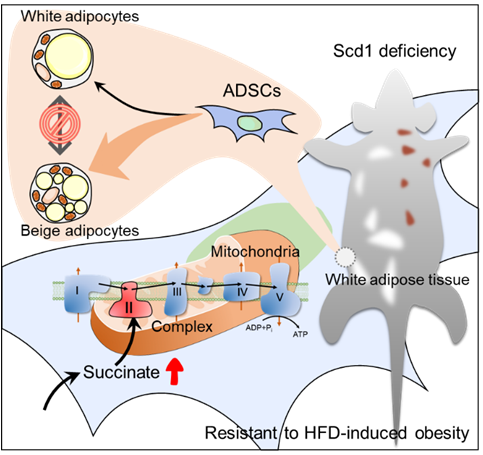- Home >> ALL News >> Highlights
Succinate Promotes de novo Beige Fat Biogenesis
In mammals, adipose tissue has a crucial role in regulating systemic energy homeostasis. In addition to the disruption of the balance between food intake and energy expenditure, the disturbance of the balance between white adipose tissue and brown/beige adipose tissue can also cause obesity and subsequent metabolic diseases. White adipose tissue is a major energy reservoir and its unhealthy expansion often results in severe fat tissue dysfunction and induces undesirable ectopic fat deposition. Since brown/beige adipocytes can consume excess energy for thermogenesis, strategies for beige fat biogenesis have attracted much attention.
As evolutionarily conserved mechanisms, hypothermia, exercise, and fasting is well known to induce beige fat generation in mammals. These systemic impacts could induce white adipocyte trans-differentiation into brown adipocytes, a process called “beiging”. It has also been reported that white and beige adipocytes are from common precursor cells (adipose tissue derived mesenchymal stem cells, ADSCs). However, to specifically promote the generation of beige adipocytes has been a long-lasting goal of the scientific community.
A new study published in Proceedings of the National Academy of Sciences (USA) elegantly answered the question. As her Ph.D. dissertation, Dr. LIU Keli in the team of Drs. SHI Yufang and WANG Ying at the Shanghai Institute of Nutrition and Health, of Chinese Academy of Sciences discovered a critical role of Scd1 (stearoyl-coenzyme A desaturase 1) and succinate in regulating beige adipogenesis of adipose precursor cells, providing a new potential target for the treatment of obesity and related metabolic diseases. This finding was originated from analysis of mice with deficiency of Scd1, a rate-limiting enzyme for the synthesis of monounsaturated fatty acids.
By generating a series of Scd1-related transgenic mice and performing various in vitro differentiation experiments, the team found a key role of mitochondrial complex II activity in dictating the beige adipogenesis of Scd1 deficient ADSCs. Specific deletion of Scd1 only in ADSCs was able to provide resistance to obesity and type 2 diabetes. Further analysis using metabolomics and transcriptomics analysis demonstrated that it was succinate that sharpened the activity of mitochondrial complex II and promoted the beige adipogenesis of ADSCs. More importantly, the addition of succinate in drinking water can augment the formation of beige fat in vivo, and thus protect mice from high-fat diet induced obesity. This study highlighted a new negative regulatory relationship between Scd1 and succinate during adipogenesis, holding great potentials for combating obesity.
This research entitled “Scd1 controls de novo beige fat biogenesis through succinate-dependent regulation of mitochondrial complex II” was published online on Jan. 17th, 2020. It was a collaborative study by the Shanghai Institute of Nutrition and Health of the Chinese Academy of Sciences, Shanghai University of Science and Technology, and the First Affiliated Hospital of Soochow University.

Succinate promotes beige adipogenesis of ADSCs.
Scd1 deficient mice possess enriched beige adipocytes and resist metabolic stress. These effects are due to the upregulated formation of beige adipocytes generated from ADSCs. Mechanistically, Scd1 deficiency induces succinate accumulation and fuels the activities of mitochondrial complex II. More importantly, succinate supplement is sufficient to reorientate the fate of ADSCs to beige adipocytes. ADSCs, adipose tissue derived mesenchymal stem cells; Scd1, stearoyl-coenzyme A desaturase 1.
(Image by Drs. SHI Yufang and WANG Ying's group)
Media Contact:
WANG Jin (Ms.)
Shanghai Institute of Nutrition and Health,
Chinese Academy of Sciences
Email: sibssc@sibs.ac.cn


